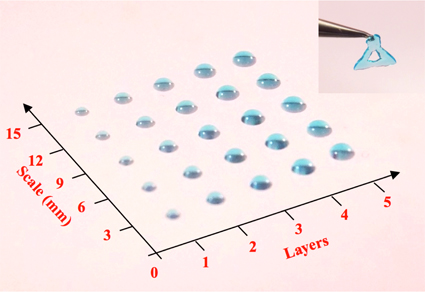Beijing, March 16, 2015, –Can organs of a living body be artificially 3D printed and replace the “original” organs one day? The cooperation research of “DNA hydrogel” by Prof. Liu Dongsheng’s group, Department of Chemistry, Tsinghua University and the group of Will Shu (Shu Wenmiao) from Watt University, UK is putting one step forward towards this dream.

Recently, DNA hydrogel accomplished by the group of Dongsheng Liu from Tsinghua University, and the group of Will Shu (Shu Wenmiao) from Watt University, UK was successfully applied to 3D printing of living cells. The research was published on Angew. Chem., Int. Ed. (DOI: 10.1002/anie.201411383) and reported as “Press Release”. On February 26, 2015,the achievement was highlighted by Nature Research Highlight, in which the material was commented as “a very promising material to print three-dimensional tissues and artificial organs.”
Nature also commented that: “This hydrogel can be used to construct structures in centimetre-level by a multi-layer printing process,” and “the hydrogel is strong enough to maintain its shape without collapse or swelling, but it can also be broken down easily by DNA-digesting enzymes”, “the printed cells survived the printing process and remained functional.”

Due to its high water content and similarity to the extracellular matrix (ECM), hydrogel is a preferred material for three-dimensional tissue printing and artificial organs fabrication, which becomes a hot field in chemistry, material, biology and medicine. However, before this DNA hydrogels was developed, there is no hydrogel material that can meet all the harsh requirements of 3D bioprinting including biocompatibility, mechanical strength, permeability, rapid prototyping, etc.

Regarding to the breakthrough of this research, Prof. Dongsheng Liu explains: “the significance of this achievement is that we have prepared a new type of hydrogel material that can meet the needs of 3D bioprinting with living cells: rapid formation in seconds scale; mild conditions, the process is fully completed under physiological conditions, not involving any chemical reaction or other external stimuli which can cause damage to cells; proper strength and good permeability make the printed product can be in centimeter scale without deformation or shrinking, and can also ensure the transport of nutrients required for cell growth; good thixotropic properties and self-healing properties make this gel can adapt itself to offer enough structural support for cell growth, without limiting its amplification; and more importantly, the gel material can be rapidly digested without residues contributing to 3D printing of organs and transplants in vivo in the future.”
Related Links:
http://www.nature.com/nature/journal/v518/n7540/full/518458c.html
http://onlinelibrary.wiley.com/journal/10.1002/(ISSN)1521-3773/homepage/press/201505press.html